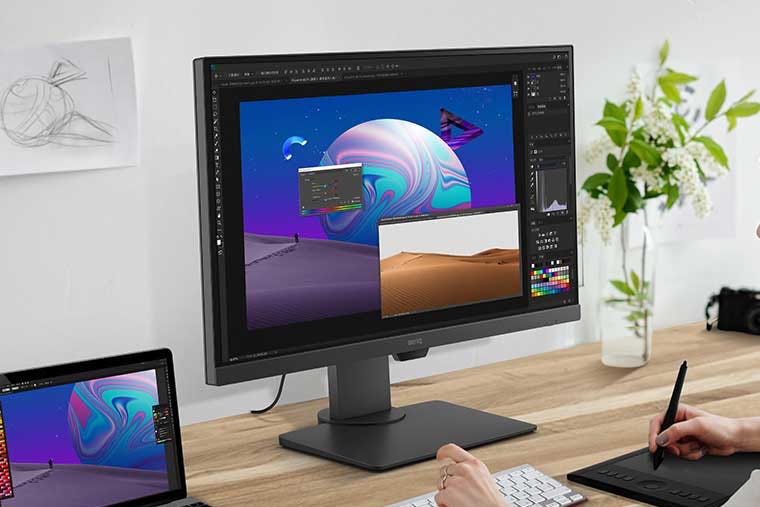

Monitor Buying Guide
Need a new monitor? Or getting your first monitor. There are key aspects that need to be considered when making such a purchase to avoid disappointment. This guide will help you choose the perfect monitor match to your setup focusing on the exploration of different uses of monitors and the monitors features.
Types of uses
Consider the actual use and purpose of use of the monitor. The table below explores the most common options.


General Use
For general use, including surfing the web, social media, watching videos and working from home. This type of use will not require a specialist monitor. Most of the monitors that are released will suit the general use purposes. The key things to consider would be; screen sizes and screen resolution. Depending on how much video watching is taking place and the personal preference for screen sizing.


Professional
Professional use includes using the monitor for graphic design and video editing purposes. This type of use requires a more in-depth purchase decision. Monitors should have a good colour accuracy which usually include; IPS settings, a bigger resolution, screen size and response times focus.


Gaming
Gaming use focuses more on the specifications of the monitor to provide the smoothest gaming experience possible. This includes response time, refresh rates, Sync technology for the ultimate gaming experience.
What kind of panel do I need?
There are three panel types in a monitor that you can choose from. The panel type is what the monitor screen is made from. There are pros and cons of each of them, with the key factor being the use guiding which panel type you should consider.The three types are: TN (Twisted nematic) panels, IPS (in-plane switching) panels and VA (vertical alignment) panels. The chart below explains the charasteristics of the different panels and the most suitable uses. Please note with panels the more features the more expensive the monitor.
| TN | VA | IPS | |
|---|---|---|---|
| Pros | High response rates, minimal motion blur | Better viewing angles, slightly better colour depth compared to TN, average response times. Best contrast ratio. | Highest Colour depth with best viewing angles | Cons | Narrow viewing angles, no colour depths resulting in lower contrast ratios | Older monitor panels low refresh rates, high price points on newer panels with better refresh rates | Older monitor panels low refresh rates, high price points | Use | Gaming | General | Professional |
| Price | £ | ££ | £££ |
What monitor screen size would fit my needs?
Monitor screen size are measured from corner to corner in a diagonal line with using inches as the metric. The screen size that you choose depends on your use and budget factors. For most users between 21.5 and 30 is the ideal screen size. Anything above these measurements could be tricky to fit on a standard desk space. If you do not have a dedicated work space or have a very small desk you might want to consider smaller sizes and portable monitors. Anything above the 30 inch mark can be great if you have a large workspace and is ideal if you want to see every little detail at one glance.


What screen resolution should I consider?
This section covers the most common resolutions. Please note that the resolution can only be as good as the GPU allows. If your GPU can only support FULL HD you will not be able to experience better resolutions than that on your monitor. You can check what resolution your GPU supports by checking the item specifics on the suppliers website.
What is a monitor resolution?
Monitor resolutions is the term of how many pixels a monitor has in width x height in pixels. The more pixels the more realistic and smooth the image. Therefore, the rule of thumb is the higher resolution number the better the image quality.
| Resolution Type | Resolution | Perfect for use |
|---|---|---|
| HD | 1280 x 720 | General |
| FULL HD | 1920 X 1080 | General |
| QUAD HD/QHD/WQHD | 2560 X 1440 | Professional, Gaming |
| 4K UHD OR ULTA HD | 3840 X 2160 | Professional, Gaming |
Should I get a curved or straight monitor?
Both types of monitors serve their purpose, it depends on the user and their needs what monitor they choose. The curved screens are usually preferred to be used by gamers or graphic designers, as they offer a ultra-wide experience. For gamers, it is the curve which allows them to immerse in the game especially in first person shooters with the reduction in reflection and glare giving them an advantage in the game. However, there are some cons when it comes to curved screen, which includes not beign able to mount them and the 27inch and less curved screens having a narrow field of view, making curved monitors expensive.
Refresh Rates and what they mean
This is usually rated in hertz (Hz), which indicates how often the image on your screen is updated resulting in a much smoother experience. This is mostly taken into account by gamers with the rapid moving content on the screen as higher refresh rate can result in faster response times. Most average displays support 60hz and are perfect for general use. The most common refresh rates for professionals and gamers are between 120hz and 165hz. Only some high end monitors have a response times between 240hz and 300hz. Please note the graphic card needs to be checked for refresh rates above 60hz if it has enough power to back it up. This can be found on the specification pages for your graphic cards.
Response Times and what they mean
Response time refers to the time it takes for monitor pixels to change from one colour to another. This is measured in milliseconds. This is not a factor that is taken into consideration when purchasing a monitor for general or professional use. This plays a significant role for gaming use only. Especially, fast moving games a lower response rate can change the whole outlook of the game. Anything under 5ms is generally good but the lower the response rate the better. If you are a pro gamer you are looking for 1ms monitors.











